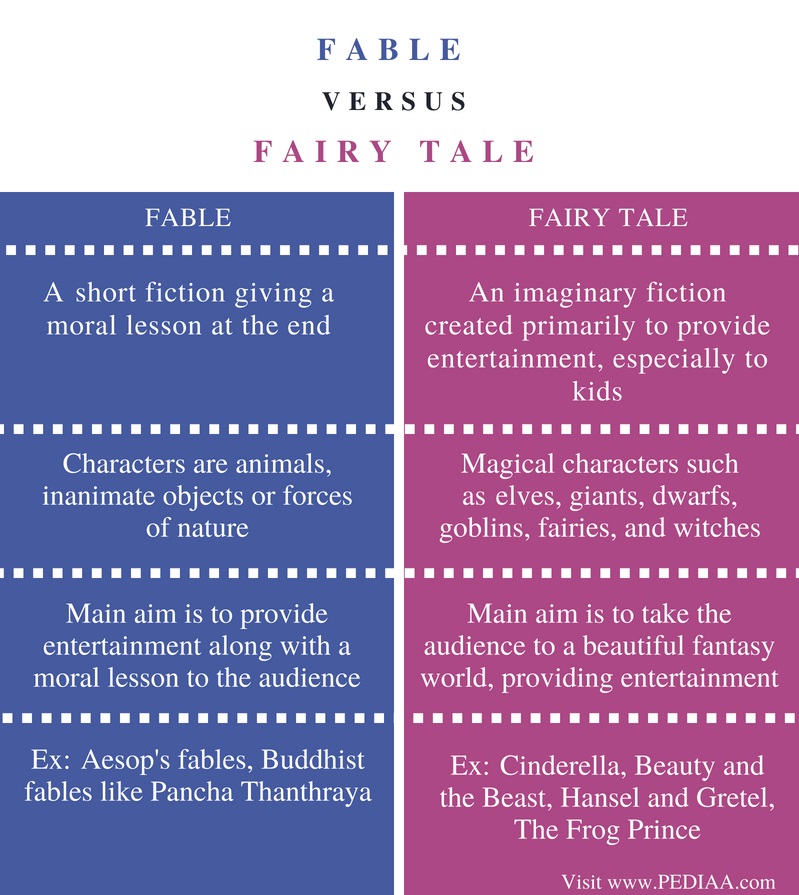Folk Tales And Fables

Main Difference – Folktale vs FableFolktales and fables are two types of stories. Folktale is a story originating in popular culture, typically passed on by word of mouth. A fable is a short story, typically with animals as characters, conveying a. The main difference between folktale and fable is that fables always teach a moral lesson to the readers, but not all folktales have a moral.
Let’s look at all these differences between folktales and fables in this article. What is a FolktaleA folktale is a story originating in popular culture, typically passed on by word of mouth. The term “folktales” actually covers a broad range of different types of story, including, adventure stories, fairy tales and stories relating to the deeds of well-known historical figures. Folktales can include material from other sources such as history and religion.Folktales are anonymous; they have no exact author, and they passed on by word of mouth.
Folktales speak to universal and timeless themes, and help folks make sense of their existence or cope with the world in which they live. Choose a letter to read a summary of the American folktales & stories beginning with that letter.
Folktales are also place-specific; different countries their own folktales. Some folktales have different versions in different regions.Folktales can have different types of characters – humans, animals, demons, gods, plants, etc.
Folktales also can teach a moral lesson to their listeners, but not all folktales have lessons. What is a FableFables are a particular type of stories, in which animals, plants, mythical creatures, or other similar characters are given human qualities so that they act like humans. This quality of attributing human qualities to animals is known as. Fables often deliver a moral lesson: this moral lesson may be explicitly stated at the end of the fable.Some fables have known authors, while there are some others who have unknown origins. “Aesop’s Fables” is a perfect example for fables. Many popular tales such as hare and the tortoise, lion and the mouse, ants and the grasshopper, crow and the pitcher, fox and the grapes, etc.
All these stories deliver a moral lesson at the end.Difference Between Folktale and Fable DefinitionFolktales are stories originating in popular culture, typically passed on by word of mouth.Fables are short stories, typically with animals as characters, conveying a moral. AuthorshipFolktales do not have an author.Fables may or may not have an author. MoralFolktales may or may not have a moral.Fables always have a moral. CharactersFolktales have a mixture of characters – humans, animals, supernatural creatures, etc.Fables have animals, plants, mythical creatures, or other similar characters that are given human qualities. VariationsFolktales may have different variations.Fables are usually uniform, especially the ones that are written down.Image Courtesy:by – (Public Domain) viaBy Laura Valentine – (Public Domain) via.

FablesFables are a particular type of narrative, in which animals, plants or similar characters are anthropomorphized, or made to seem as if they were human. Stories of this type often deliver a moral lesson, which may or may not be explicitly stated at the end.
Some fables are the work of known authors, while others are of unknown origin. The best known collection of fables is 'Aesop's Fables,' although it is uncertain whether a historical Aesop ever existed. FolktalesThe term 'folktales' encompasses a wide variety of different types of story, including ghost stories, fairy tales and semi-historical stories relating to the deeds of famous people. In order to truly be a folktale, a story should be the product of a traditional, often oral, narrative, rather than the creative work of a particular author. Folktales can include material from other sources, such as the Christian folktales of medieval Europe, which attributed fantastic adventures to saints and characters from the Bible. Differences in ContentThe key difference in content between folktales and fables is that although some folktales are fables, fables are far from the only type of folktale. Folktales may include stories of anthropomorphized animals with moral themes, but they may also include adventure stories or ghost stories.
In terms of content, then, the difference between folktales and fables is that the body of folk stories is larger and more diverse, containing some fables but not limited to them. Differences in AuthorshipThe other key difference between folktales and fables is authorship. A story is only really a folktale if it belongs to a traditional body of stories, told and retold in a variety of ways among a society. However, not all fables are like this. Some fables are works of literature created by known authors such as French author Jean de la Fontaine or English satirist John Gay. Although some fables have the same traditional background as folktales, it is not necessarily always the case. Ecco the dolphin wiki.
River city girls marian. River City Girls does have its silly moments despite all the ass-kicking going on. Let's think about it. The fact that the developers made a different secret ending after fans practically threatened to beat the crap out of them. One has to wonder if the comical violence isn't limited to the world. The storyline ( but not the gameplay) of River City Ransom was continued in the ( also Japan only) game Downtown Nekketsu Kōshinkyoku: Soreyuke Dai Undōkai. Oddly enough America did get the sequel to Soreyuke Dai Undōkai, which was localized as Crash 'n' the Boys: Street Challenge. Over the course of the game, River City Girls players will eventually run into Billy and Jimmy Lee as well as Marian Kelly, who runs an accessory store called Swaggage. River City Girls on the other hand leans more toward the original Japanese games, with the use of the original Japanese names for most of the cast, has a lighter aesthetic, and the cast are still high-schoolers in a more contemporary time period.
- среда 22 апреля
- 53